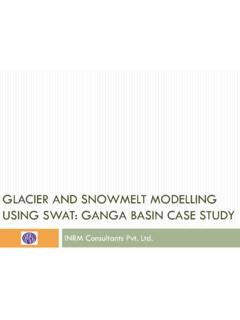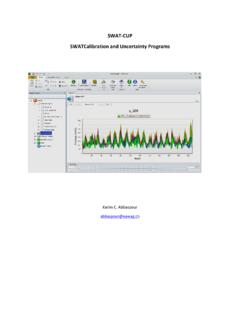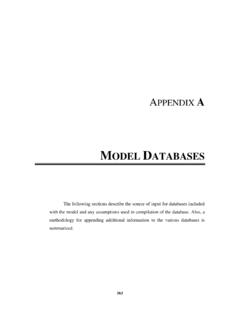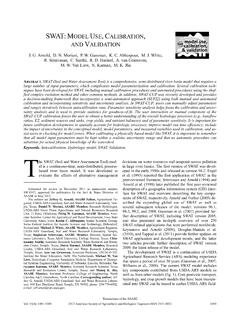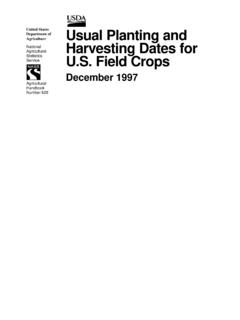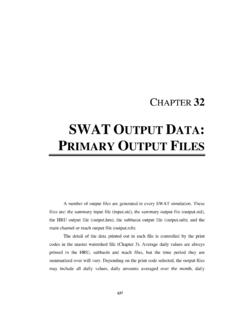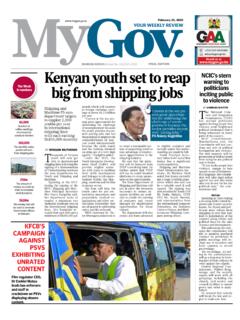Transcription of D. N. Moriasi, J. G. Arnold, M. W. Van Liew, R. L. Bingner ...
1 Transactions of the ASABEVol. 50(3): 885 900 2007 American Society of Agricultural and Biological Engineers ISSN 0001 2351885 MODEL EVA L U AT I O N GUIDELINES FOR SYSTEMATICQUANTIFICATION OF ACCURACY IN WATERSHED SIMULATIONSD. N. moriasi , J. G. Arnold, M. W. Van Liew, R. L. Bingner , R. D. Harmel, T. L. VeithABSTRACT. Watershed models are powerful tools for simulating the effect of watershed processes and management on soil andwater resources. However, no comprehensive guidance is available to facilitate model evaluation in terms of the accuracyof simulated data compared to measured flow and constituent values. Thus, the objectives of this research were to:(1) determine recommended model evaluation techniques (statistical and graphical), (2) review reported ranges of values andcorresponding performance ratings for the recommended statistics, and (3) establish guidelines for model evaluation basedon the review results and project-specific considerations; all of these objectives focus on simulation of streamflow andtransport of sediment and nutrients.
2 These objectives were achieved with a thorough review of relevant literature on modelapplication and recommended model evaluation methods. Based on this analysis, we recommend that three quantitativestatistics, Nash-Sutcliffe efficiency (NSE), percent bias (PBIAS), and ratio of the root mean square error to the standarddeviation of measured data (RSR), in addition to the graphical techniques, be used in model evaluation. The following modelevaluation performance ratings were established for each recommended statistic. In general, model simulation can be judgedas satisfactory if NSE > and RSR < , and if PBIAS + 25% for streamflow, PBIAS + 55% for sediment, and PBIAS+ 70% for N and P. For PBIAS, constituent-specific performance ratings were determined based on uncertainty of measureddata. Additional considerations related to model evaluation guidelines are also discussed.
3 These considerations include:single-event simulation, quality and quantity of measured data, model calibration procedure, evaluation time step, and projectscope and magnitude. A case study illustrating the application of the model evaluation guidelines is also Accuracy, Model calibration and validation, Simulation, Watershed watershed models can save timeand money because of their ability to perform long-term simulation of the effects of watershed pro-cesses and management activities on water quality,water quantity, and soil quality. These models also facilitatethe simulation of various conservation program effects andaid policy design to mitigate water and soil quality degrada-tion by determining suitable conservation programs for par-ticular watersheds and agronomic settings. In order to usemodel outputs for tasks ranging from regulation to research,models should be scientifically sound, robust, and defensible( EPA, 2002).
4 Submitted for review in May 2006 as manuscript number SW 6494; ap-proved for publication by the Soil & Water Division of ASABE in authors are Daniel N. moriasi , ASABE Member Engineer,Hydrologist, USDA-ARS Grazinglands Research Laboratory, El Reno,Oklahoma; Jeffrey G. Arnold, Supervisory Agricultural Engineer, USDA-ARS Grassland Soil and Water Research Laboratory, Temple, Texas; Mi-chael W. Van Liew, ASABE Member Engineer, Environmental ScienceSpecialist, Water Quality Planning Bureau, Montana Department of Envi-ronmental Quality, Helena, Montana; Ronald L. Bingner , ASABE Mem-ber Engineer, Agricultural Engineer, USDA-ARS Watershed Physical Pro-cesses Research Unit, Oxford, Mississippi; R. Daren Harmel, ASABEM ember Engineer, Agricultural Engineer, USDA-ARS Grassland Soil andWater Research Laboratory, Temple, Texas; and Tamie L. Veith, ASABEM ember Engineer, Agricultural Engineer, USDA-ARS Pasture Systemsand Watershed Management Research Unit, University Park, Pennsylva-nia.
5 Corresponding author: Daniel N. moriasi , USDA-ARS GrazinglandsResearch Laboratory, 7207 W. Cheyenne St., El Reno, OK 73036-0000;phone: 405-262-5291, ext. 263; fax: 405-262-0133; e-mail: analysis is the process of determining the rateof change in model output with respect to changes in modelinputs (parameters). It is a necessary process to identify keyparameters and parameter precision required for calibration(Ma et al., 2000). Model calibration is the process of estimat-ing model parameters by comparing model predictions (out-put) for a given set of assumed conditions with observed datafor the same conditions. Model validation involves runninga model using input parameters measured or determined dur-ing the calibration process. According to Refsgaard (1997),model validation is the process of demonstrating that a givensite-specific model is capable of making sufficiently accu-rate simulations, although sufficiently accurate can varybased on project goals.
6 According to the EPA (2002), theprocess used to accept, reject, or qualify model results shouldbe established and documented before beginning model eval-uation. Although ASCE (1993) emphasized the need to clear-ly define model evaluation criteria, no commonly acceptedguidance has been established, but specific statistics and per-formance ratings for their use have been developed and usedfor model evaluation (Donigian et al., 1983; Ramanarayananet al., 1997; Gupta et al., 1999; Motovilov et al., 1999; Salehet al., 2000; Santhi et al., 2001; Singh et al., 2004; Bracmortet al., 2006; Van Liew et al., 2007). However, these perfor-mance ratings are model and project specific. Standardizedguidelines are needed to establish a common system for judg-ing model performance and comparing various models(ASCE, 1993). Once established, these guidelines will assistmodelers in preparing and reviewing quality assurance proj-ect plans for modeling ( EPA, 2002) and will increase ac-countability and public acceptance of models to supportC886 TRANSACTIONS OF THE ASABE scientific research and to guide policy, regulatory, and man-agement number of publications have addressed model evalua-tion statistics (Willmott, 1981; ASCE, 1993; Legates andMcCabe, 1999), but they do not include recently developedstatistics ( , Wang and Melesse, 2005; Parker et al.)
7 , 2006).More importantly, none of the previous publications provideguidance on acceptable ranges of values for each and Bera (2004) present an excellent review of valuesfor various statistics used in hydrologic and nonpoint-sourcemodel applications, but more elaborate analysis is needed toaid modelers in determining performance ratings for most watershed modeling projects, model output iscompared to corresponding measured data with the assump-tion that all error variance is contained within the predictedvalues and that observed values are error free. In discussionsof model evaluation statistics, Willmott (1981) and ASCE(1993) do recognize that measured data are not error free, butmeasurement error is not considered in their recommenda-tions perhaps because of the relative lack of data on measure-ment uncertainty. However, uncertainty estimates formeasured streamflow and water quality data have recentlybecome available (Harmel et al.
8 , 2006) and should be consid-ered when calibrating, validating, and evaluating watershedmodels because of differences in inherent uncertainty be-tween measured flow, sediment, and nutrient importance of standardized guidelines for modelevaluation is illustrated by the Conservation Effects Assess-ment Project Watershed Assessment Study (CEAP-WAS,2005). The CEAP-WAS seeks to quantify the environmentalbenefits of conservation practices supported by USDA in the2002 Farm Bill, also known as the Farm Security and RuralInvestment Act. One of the CEAP-WAS goals is to formulateguidelines for calibration, validation, and application ofmodels used in CEAP to simulate environmental effects ofconservation practices. Thus, based on the need for standard-ized model evaluation guidelines to support watershed mod-eling in CEAP-WAS and other projects, the objectives for thepresent research were to: (1) determine recommended modelevaluation techniques (statistical and graphical), (2) reviewreported ranges of values and corresponding performanceratings for the recommended statistics, and (3) establishguidelines for model evaluation based on the review resultsand project-specific considerations.
9 In addition, a case studyillustrating the application of the model evaluation guide-lines was provided. This research focuses on watershed mod-el evaluation guidelines for streamflow, sediments, andnutrients. Throughout this article, model evaluation refersto the applicable steps of sensitivity analysis, calibration, val-idation, uncertainty analysis, and EVA L U AT I O N TECHNIQUESTo determine recommended techniques for watershedmodel evaluation, an extensive review was conducted onpublished literature related to calibration, validation, and ap-plication of watershed models. Specifically, the informationcompiled focused on the strengths and weaknesses of eachstatistical and graphical technique and on recommendationsfor their application. The recommended model evaluationstatistics were selected based on the following factors: (1) ro-bustness in terms of applicability to various constituents,models, and climatic conditions; (2) commonly used, accept-ed, and recommended in published literature; and (3) identi-fied strengths in model evaluation.
10 The trade-off betweenlong-term bias and residual variance was also considered, asrecommended by Boyle et al. (2000). Bias measures the aver-age tendency of the simulated constituent values to be largeror smaller than the measured data. Residual variance is thedifference between the measured and simulated values, oftenestimated by the residual mean square or root mean square er-ror (RMSE). According to Boyle et al. (2000), optimizingRMSE during model calibration may give small error vari-ance but at the expense of significant model bias. The com-pilation of recommended statistics was also constrained bythe recommendation of Legates and McCabe (1999) to in-clude at least one dimensionless statistic and one absolute er-ror index statistic with additional information such as thestandard deviation of measured data, and to include at leastone graphical technique as VALUE RANGES AND PERFORMANCE RAT I NGSFOR RECOMMENDED STATISTICSA dditional literature review was conducted to determinepublished ranges of values and performance ratings for rec-ommended model evaluation statistics.

